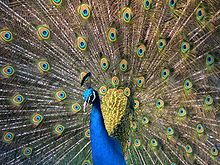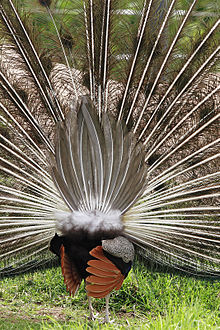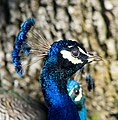Peafowl: Difference between revisions
m rv random Americanisation of an Old world sp |
|||
| Line 56: | Line 56: | ||
The male peafowl, or peacock, has long been known and valued for its brilliant tail feathers. The bright spots on it are known as "eyes", and inspired the [[Greek myth]] that [[Hera]] placed the hundred [[eyes]] of her slain giant [[Argus]] on the tail of her favorite bird. |
The male peafowl, or peacock, has long been known and valued for its brilliant tail feathers. The bright spots on it are known as "eyes", and inspired the [[Greek myth]] that [[Hera]] placed the hundred [[eyes]] of her slain giant [[Argus]] on the tail of her favorite bird. |
||
Indian Peafowl is iridescent blue-green or blue in the head, neck and breast. The back, or scapular, feathers are vermiculated in black and white, while the primaries are orange-chestnut. The so-called "tail" of the peacock, also termed the "train," is not the tail quill feathers but highly elongated upper tail feather [[covert feather|covert]]s. It is mostly bronze-green, with a series of eyes that are best seen when the train is fanned. The actual tail feathers are short and |
Indian Peafowl is iridescent blue-green or blue in the head, neck and breast. The back, or scapular, feathers are vermiculated in black and white, while the primaries are orange-chestnut. The so-called "tail" of the peacock, also termed the "train," is not the tail quill feathers but highly elongated upper tail feather [[covert feather|covert]]s. It is mostly bronze-green, with a series of eyes that are best seen when the train is fanned. The actual tail feathers are short and grey-coloured and can be seen from behind when a peacock's train is fanned in a courtship display. During the molting season, the males shed their stunning train feathers and reveal the unassuming grey-coloured tail which is normally hidden from view beneath the train. Both species have a crest atop the head which is also present in the females. |
||
The female (peahen) Indian Peafowl is duller in comparison. It is mostly brown, with pale underparts and some green iridescence in the neck, and lacks the long upper tail feather coverts of the male. |
The female (peahen) Indian Peafowl is duller in comparison. It is mostly brown, with pale underparts and some green iridescence in the neck, and lacks the long upper tail feather coverts of the male. |
||
| Line 64: | Line 64: | ||
Unlike the Indian Peafowl, the Green Peahen is very similar to the male, only having shorter upper tail feather coverts and slightly less iridescent in some regions. Like other peafowl, it is very difficult to distinguish a juvenile male from an adult female. Moreover, the sexes of the various Green Peafowl species are almost impossible to tell apart in the field during the months when the male has no train. |
Unlike the Indian Peafowl, the Green Peahen is very similar to the male, only having shorter upper tail feather coverts and slightly less iridescent in some regions. Like other peafowl, it is very difficult to distinguish a juvenile male from an adult female. Moreover, the sexes of the various Green Peafowl species are almost impossible to tell apart in the field during the months when the male has no train. |
||
Many of the brilliant |
Many of the brilliant colours of the peacock plumage are due to an optical [[interference]] phenomenon ([[Bragg reflection]]) based on (nearly) periodic nanostructures found in the [[barbule]]s (fiber-like components) of the feathers. Such interference-based ''structural colour'' is especially important in producing the peacock's [[iridescent]] hues (which shimmer and change with viewing angle), since interference effects depend upon the angle of light, unlike chemical pigments. |
||
The plumage of the peacock, and the peahen's preference for its exorbitance, is a classical example of [[sexual selection]] and especially the [[handicap principle]]. However, in recent years scientific research has shown that the size and brilliance of a male's plumage does not meaningfully correlate with his mating success nor his health, and that instead the key factor for attracting females is the vocalizations made prior to mating. <ref>{{cite web|url=http://dsc.discovery.com/news/2008/03/26/peacock-feathers-females.html |title=Discovery News : Discovery Channel |publisher=Dsc.discovery.com |date= |accessdate=2009-04-05}}</ref> |
The plumage of the peacock, and the peahen's preference for its exorbitance, is a classical example of [[sexual selection]] and especially the [[handicap principle]]. However, in recent years scientific research has shown that the size and brilliance of a male's plumage does not meaningfully correlate with his mating success nor his health, and that instead the key factor for attracting females is the vocalizations made prior to mating. <ref>{{cite web|url=http://dsc.discovery.com/news/2008/03/26/peacock-feathers-females.html |title=Discovery News : Discovery Channel |publisher=Dsc.discovery.com |date= |accessdate=2009-04-05}}</ref> |
||
| Line 93: | Line 93: | ||
Image:Peahen on Saint Thomas, United States Virgin Islands.jpg|An Indian Blue Peahen showing her plumage |
Image:Peahen on Saint Thomas, United States Virgin Islands.jpg|An Indian Blue Peahen showing her plumage |
||
Image:040411.JPG|Closeup of an Indian Blue Peacock's head |
Image:040411.JPG|Closeup of an Indian Blue Peacock's head |
||
File:Black-Shouldered Peacock.jpg|The Black-Shouldered Peacock was once thought to be a distinct subspecies, but is now considered a |
File:Black-Shouldered Peacock.jpg|The Black-Shouldered Peacock was once thought to be a distinct subspecies, but is now considered a colour mutation |
||
Image:White_peacock.jpg|A white peacock showing off his plumage |
Image:White_peacock.jpg|A white peacock showing off his plumage |
||
Image:Male Indian Blue Peacock head.jpg|The head of a male Indian Blue Peacock |
Image:Male Indian Blue Peacock head.jpg|The head of a male Indian Blue Peacock |
||
| Line 128: | Line 128: | ||
| issue = 1 |
| issue = 1 |
||
| pages = 18–20 |
| pages = 18–20 |
||
| date = Jan. |
| date = Jan. 2004 |
||
| publisher = |
| publisher = |
||
| url = http://www.aip.org/pt/vol-57/iss-1/p18.html |
| url = http://www.aip.org/pt/vol-57/iss-1/p18.html |
||
Revision as of 05:24, 29 May 2009
It has been suggested that this article be merged with Pavo (genus), Talk:Pavo (genus) and Richard001. (Discuss) Proposed since August 2008. |
This article needs additional citations for verification. (April 2008) |
| Peafowls/Peacocks | |
|---|---|

| |
| An Indian Blue Peacock (rear) courts a peahen (front) | |
| Scientific classification | |
| Kingdom: | |
| Phylum: | |
| Class: | |
| Order: | |
| Family: | |
| Genus: | |
| Species | |
|
Pavo antiquus | |
The term peafowl can refer to the two species of bird in the genus Pavo of the pheasant family, Phasianidae. The African Congo Peafowl is placed in its own genus Afropavo. Peafowl are best known for the male's extravagant tail feathers, which it displays as part of courtship. The male is called a peacock, the female a peahen[1], though it is common to hear the female also referred to as a "peacock."
The two species are:
- Indian Peafowl, Pavo cristatus is a resident breeder in the Indian subcontinent. The peacock is designated as the national bird of India.
- Green Peafowl, Pavo muticus breeds from Burma east to Java. The IUCN lists the Green Peafowl as vulnerable to extinction due to hunting and a reduction in extent and quality of habitat.
Taxonomy

The Indian Peafowl is monotypic, while the Green Peafowl has 3 subspecies, P. muticus spicifer, P. m. imperator and the nominate P. m. muticus.[2] The two species are largely allopatric but will hybridize in captivity.
While the form of Green Peafowl in Yunnan is not separated taxonomically, it differs in a few aspects from other forms, particularly in its forest-dwelling habits, an "odd, monal-like bill," a curiously long hind toe and longer, more slender wings (K. B. Woods in litt. 2000) [3]. Some pheasant breeders have suggested that the Green Peafowl may have more subspecies.[4][5]
Peafowl have sometimes been included in a distinct family from Pheasants [6].
Plumage

The male peafowl, or peacock, has long been known and valued for its brilliant tail feathers. The bright spots on it are known as "eyes", and inspired the Greek myth that Hera placed the hundred eyes of her slain giant Argus on the tail of her favorite bird.
Indian Peafowl is iridescent blue-green or blue in the head, neck and breast. The back, or scapular, feathers are vermiculated in black and white, while the primaries are orange-chestnut. The so-called "tail" of the peacock, also termed the "train," is not the tail quill feathers but highly elongated upper tail feather coverts. It is mostly bronze-green, with a series of eyes that are best seen when the train is fanned. The actual tail feathers are short and grey-coloured and can be seen from behind when a peacock's train is fanned in a courtship display. During the molting season, the males shed their stunning train feathers and reveal the unassuming grey-coloured tail which is normally hidden from view beneath the train. Both species have a crest atop the head which is also present in the females.
The female (peahen) Indian Peafowl is duller in comparison. It is mostly brown, with pale underparts and some green iridescence in the neck, and lacks the long upper tail feather coverts of the male.
The Green Peafowl is very different in appearance to the Indian Peafowl. The male has green and gold plumage and has an erect crest. The wings are black with a sheen of blue.
Unlike the Indian Peafowl, the Green Peahen is very similar to the male, only having shorter upper tail feather coverts and slightly less iridescent in some regions. Like other peafowl, it is very difficult to distinguish a juvenile male from an adult female. Moreover, the sexes of the various Green Peafowl species are almost impossible to tell apart in the field during the months when the male has no train.
Many of the brilliant colours of the peacock plumage are due to an optical interference phenomenon (Bragg reflection) based on (nearly) periodic nanostructures found in the barbules (fiber-like components) of the feathers. Such interference-based structural colour is especially important in producing the peacock's iridescent hues (which shimmer and change with viewing angle), since interference effects depend upon the angle of light, unlike chemical pigments.
The plumage of the peacock, and the peahen's preference for its exorbitance, is a classical example of sexual selection and especially the handicap principle. However, in recent years scientific research has shown that the size and brilliance of a male's plumage does not meaningfully correlate with his mating success nor his health, and that instead the key factor for attracting females is the vocalizations made prior to mating. [7]
Behavior

The peafowl are forest birds that nest on the ground. The Pavo peafowl are terrestrial feeders but roost in trees.
Both species of Peafowl are believed to be polygamous. However, it has been suggested that "females" entering a male Green Peafowl's territory [8] are really his own juvenile or subadult young (K. B. Woods in litt. 2000) and that Green Peafowl are really monogamous in the wild. Those who subscribe to this notion cite the similarities between the sexes. Peafowl courthips takes place in the ground; the male performs a display by fanning the train, facing the female or females in the area. This display is precededed by very loud vocalisations given by the male.
Diet
Peafowl are omnivorous and eat ticks, termites, ants, locusts, mice, plant parts, flower petals, seed heads, scorpions and other arthropods, reptiles, and amphibians.
In common with other members of the Galliformes, males and females of both species possess powerful, sharp metatarsal spurs or "kicking thorns" used primarily to protect themselves against predators and to a lesser extent during intraspecific fights.
Habitat
Open forest, bushland, thorn forest and sometimes rainforest.
Because of human encroachment into their natural territories, peafowl and humans have come into increasing contact. Because of their natural beauty some are reluctant to classify the birds as pests but their presence can be disturbing, especially given their tendency to eat indiscriminately of garden boundaries and the male's powerful vocal crow (louder than a rooster's crow).
Gallery
Indian Peafowl
-
An Indian Blue Peacock's head
-
Shot of a white peacock
-
Indian Blue Peacock, male
-
An Indian Blue Peahen showing her plumage
-
Closeup of an Indian Blue Peacock's head
-
The Black-Shouldered Peacock was once thought to be a distinct subspecies, but is now considered a colour mutation
-
A white peacock showing off his plumage
-
The head of a male Indian Blue Peacock
-
Male Indian Blue Peacock at Grounds for Sculpture in Hamilton Township, New Jersey
-
Indian Blue Peacocks as illustrated in the First Edition of the Encyclopædia Britannica
-
by Charles d'Orbigney (1806–1876)
-
A white peacock domesticated in Mexico.
-
Peacock seen in San Francisco, California
-
Closeup picture of the feathers of a peacock in Romania
Green Peafowl
-
Male
-
Female
-
Close-up of a female's head
-
Pavo muticus muticus
References
- ^ "peacock - Britannica On Encyclopedia". Britannica.com. Retrieved 2009-04-05.
- ^ Madge, S. and P. McGowan (2002) Pheasants, Partridges and Grouse ISBN 0-7136-3966-0
- ^ [1]
- ^ "Pfauenzucht Mennig". Pavo-muticus-muticus.de. Retrieved 2009-04-05.
- ^ PDF in German
- ^ "WPA - Deutschland". Wpadeutschland.de. Retrieved 2009-04-05.
- ^ "Discovery News : Discovery Channel". Dsc.discovery.com. Retrieved 2009-04-05.
- ^ Gallery :: SOUTHERN spicifer{Irrawady basin and southern Burma to the Salween drainage basin. This is the nominate form Pavo spicifer spicifer :: 19
- Kimball, Rebecca T., Edward L. Braun, and J. David Ligon (1997). Resolution of the Phylogenetic Position of the Congo Peafowl, Afropavo congensis: A Biogeographic and Evolutionary Enigma. Proceedings: Biological Sciences, vol. 264 (1387), pp. 1517–1523
- van Balen, S., Prawiradilaga, D. M. and Indrawan, M. (1995) The distribution and status of Green Peafowl in Java. Biol. Conserv. 71: 289-297.
External links
- Peafowl Varieties Database
- United Peafowl Association Knowledge Base
- Videos of Peafowls on the Internet Bird Collection
- Peacock — Etymology of the word
- Video of a peacock showing of his plumage
- Zoonomen - Zoological Nomenclature Resource — World Birds Taxonomic List as of 2006-09-26
- The Peacock Pages: All About Peacocks!, An article by Lisa Johnson from the Game Bird and Conservationists' Gazette — Aspects of the cultural role of peafowl and their place in aviculture.
- "Behavioural Ecologists Elucidated How Peahens Choose Their Mates, And Why", an article at ScienceDaily.com

















